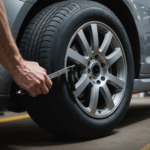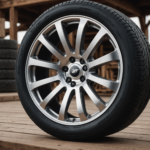Suspension modifications are a popular way to enhance the performance, handling, and aesthetics of a vehicle. However, these modifications can have a significant impact on wheel fitment, an often overlooked aspect that can affect both safety and performance. This article explores how changes to a vehicle’s suspension system influence wheel compatibility, including tire size, offset, and overall handling characteristics.
Understanding Suspension Modifications
The suspension system of a vehicle plays a crucial role in maintaining tire contact with the road, providing stability, and absorbing shocks from uneven surfaces. Modifications can range from simple changes, like upgrading shock absorbers, to more complex alterations like lowering springs, air ride systems, or full coilover kits.
Types of Suspension Modifications
- Lowering Springs: These springs reduce the ride height of a vehicle, improving aesthetics and handling by lowering the center of gravity.
- Coilovers: Adjustable coilovers offer versatility in adjusting ride height and damping to fine-tune performance.
- Air Suspension: Provides adjustable ride height and stiffness through an air compressor, allowing for both performance and convenience.
- Performance Shocks: Enhanced dampers that help control wheel movement, creating a more responsive ride.
The Role of Wheel Fitment
Wheel fitment refers to the proper alignment and compatibility of wheels with a vehicle’s suspension components. Proper fitment includes factors like offset, backspacing, and bolt pattern. Understanding these components is crucial for maintaining vehicle performance and safety.
Key Parameters of Wheel Fitment
| Parameter | Description |
|---|---|
| Offset | The distance between the wheel’s mounting surface and the centerline of the wheel. Positive offset pushes the wheel inward, while negative offset pushes it outward. |
| Backspacing | The distance from the back of the wheel to the mounting surface. This affects how far the wheel sits inside or outside the fender. |
| Bolt Pattern | The arrangement of the lug holes on the wheel. This must match the vehicle’s specifications for proper fitment. |
How Suspension Modifications Affect Wheel Fitment
When suspension modifications are made, the changes in ride height and geometry can have a direct impact on how wheels fit. Here are the primary ways that suspension alterations influence wheel fitment:
1. Changes in Ride Height
Lowering a vehicle using lowering springs or coilovers reduces the gap between the wheel arch and the tire. This can lead to:
- Increased Risk of Rubbing: Lowering a vehicle too much can cause tires to rub against the fenders or suspension components during turns or over bumps.
- Required Adjustments to Tire Size: To prevent rubbing, smaller tires may be needed, altering the overall performance characteristics of the vehicle.
2. Adjustments to Suspension Geometry
Suspension modifications also affect the angles at which wheels are positioned. These changes can impact:
- Camber Angle: Adjustments in the suspension setup can lead to positive or negative camber, affecting tire wear and handling.
- Toe Angle: Misalignment can cause tires to point inward or outward, leading to uneven tire wear and stability issues.
3. Differences in Wheel Offset
As the suspension is modified, the friction between the wheels and their surroundings changes. Altering the offset can help maintain proper alignment within the wheel arch, but it needs to be calculated carefully:
- Calculate the new offset required after the suspension modifications.
- Select wheels that match this new offset to ensure proper fitment.
Calculating Changes in Wheel Fitment Post-Suspension Modifications
To ensure safe and proper wheel fitment after suspension modifications, it is beneficial to use a systematic approach for calculations. The following formulas can aid in determining how modifications will affect wheel fitment:
1. Determining New Offset
The new offset can be calculated using the formula:
New Offset = Original Offset – (Extents of Ride Height Change)
This formula takes into account how much the ride height has changed due to suspension modifications. Accurate measurements are essential to maintain ideal performance.
2. Evaluating Backspacing Changes
Backspacing should also be recalculated based on the new rim setup. The formula is as follows:
Backspacing = (Wheel Width / 2) + Offset
Using this calculation, the appropriate installation of new wheels can be assessed.
Important Considerations for Safe Wheel Fitment
When planning suspension modifications and their impact on wheel fitment, various considerations must be taken into account:
1. Consult Professional Mechanics
It is highly recommended to consult with experienced mechanics or suspension specialists. Their expertise can provide insight on optimal fitment solutions that accommodate performance expectations.
2. Perform Regular Inspections
After modifications are made, regular inspection of wheel alignment and tire wear can help identify issues early on. This ensures ongoing performance and safety.
3. Use Quality Aftermarket Parts
Investing in high-quality suspension components and wheels is crucial. Inferior parts can lead to poor fitment and compromise vehicle safety.
Conclusion
In conclusion, suspension modifications can significantly influence wheel fitment, impacting both the performance and safety of a vehicle. Understanding how changes in ride height, suspension geometry, and wheel offset relate to fitment is essential for any car enthusiast or owner considering such modifications. By following best practices, utilizing accurate calculations, and consulting professionals, drivers can enjoy enhanced vehicle performance while maintaining optimal safety.














